This post may contain affiliate links. Please read our disclosure policy.
Learn how to make Banh cam at home! This traditional Vietnamese treat consists of sweet mung bean paste balls wrapped in glutinous rice flour wrappers and coated with sesame seeds before being deep fried to perfection. It’s crispy, chewy, and so addictive. A must-try!
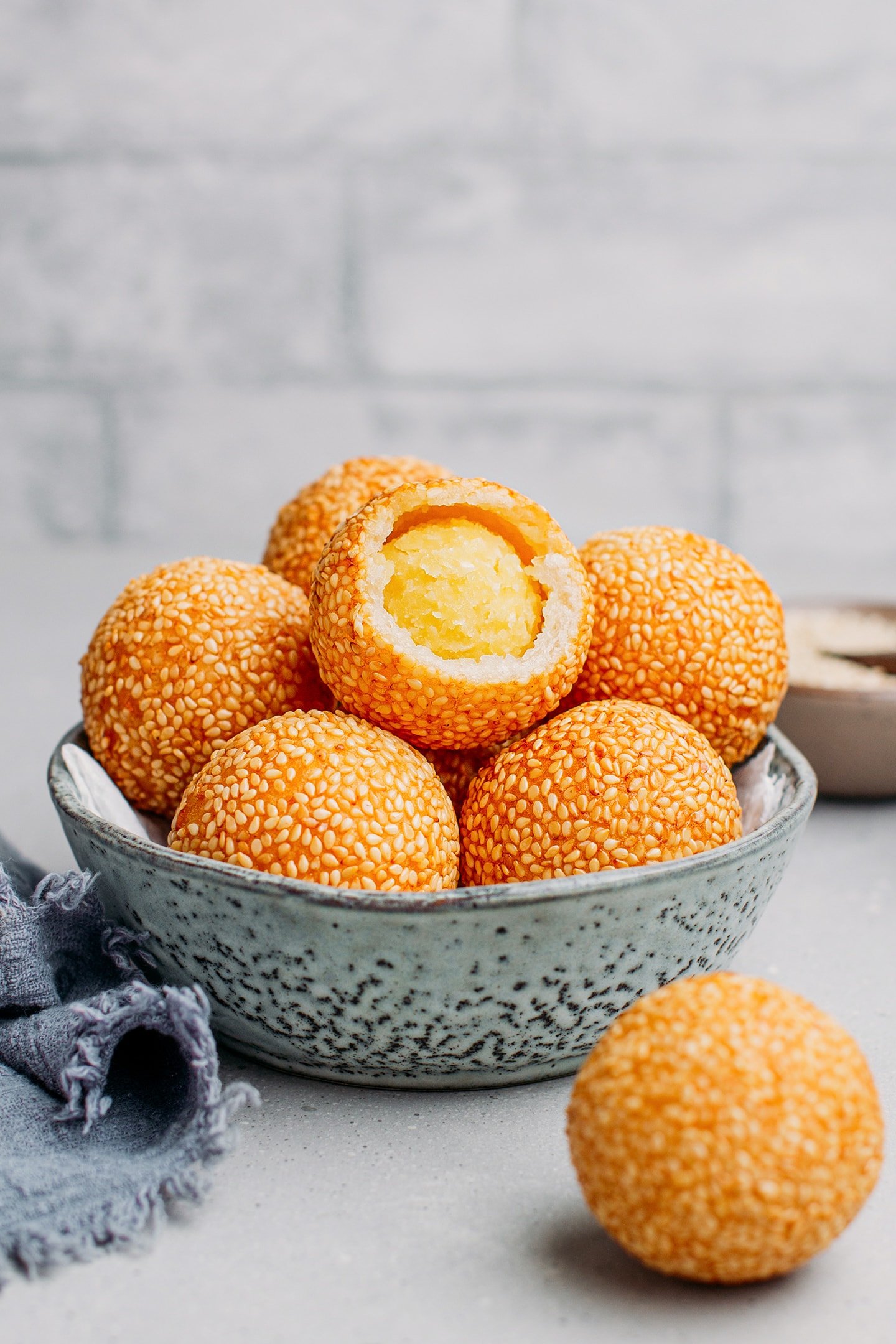
⭐️ Why You Should Try It
- A taste of Vietnam from home. We have tested plenty of Bánh cam in Vietnam, and we can safely say that these taste even better than the ones you can find sold in the streets of Saigon!
- Perfectly crispy on the outside. The crispy yet slightly chewy shell hides a tender mung bean filling infused with coconut and vanilla. Toasted sesame seeds bring another layer of crunchiness and nuttiness.
- Just 9 ingredients are required. Although this recipe may seem challenging, it is surprisingly easy to prepare! You will need only 9 common pantry ingredients. Plus, it’s fun to make, and you can even ask your kids or friends to help shape and wrap the sesame balls.
📘 What Is Banh Cam
Bánh cam, also known as “bánh rán,” is a traditional Vietnamese sweet that consists of a sweet mung bean paste filling wrapped in a glutinous rice flour shell, coated in sesame seeds, and deep-fried until golden brown. Bánh cam draws inspiration from Chinese sesame balls known as “Jian dui (煎堆)” and is sold as street food throughout Vietnam.
The words “bánh cam” translate to “orange cake,” referring to its appearance that resembles an orange.
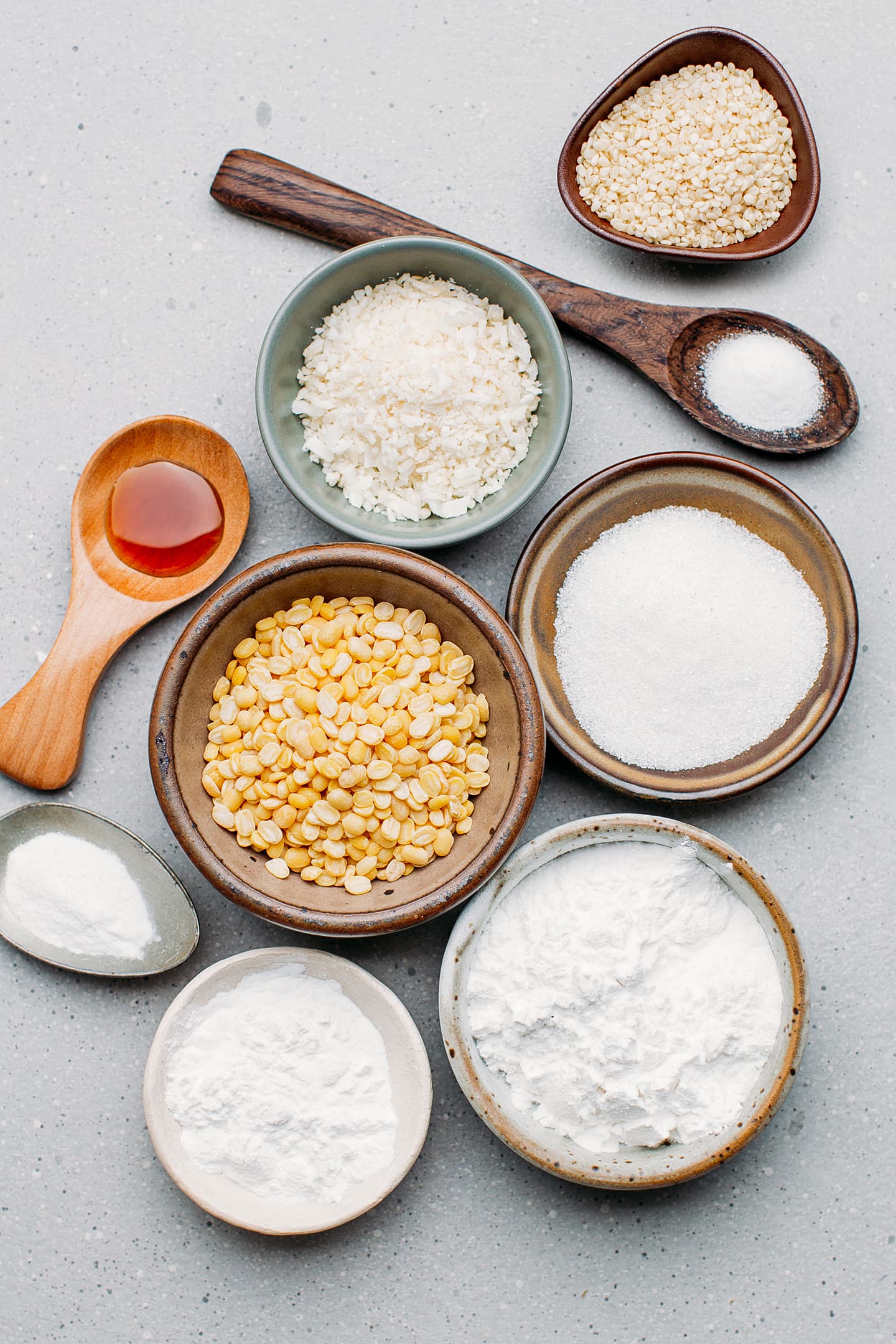
🍚 Ingredient Notes
Here is what you will need to make banh cam at home:
- Mung beans – Use split yellow mung beans, not the whole ones. Yellow mung beans have a slightly sweet and nutty flavor, whereas whole mung beans offer a more earthy flavor.
- Glutinous rice flour – Also known as sweet rice flour, it makes the base of the shell. Do not replace it with regular rice flour; you would not get the same chewiness.
- White rice flour – A small amount of white rice flour adds extra crispiness to the shell.
- Baking powder – Essential to allow the shell to puff up.
- Sugar – Use granulated white sugar. I advise against using coconut or light brown sugar, which would alter the color and flavor.
- Oil – To make the filling richer and prevent it from sticking to the shell. Any neutral oil works. A few options are canola, grapeseed, or sunflower oil.
- Shredded coconut – Optional. It brings a delicate nuttiness and subtle coconut flavor. Worry not, it’s not overpowering.
- Vanilla extract – Vanilla extract takes the mung bean filling to the next level by adding a fresh and floral aroma.
- Sesame seeds – Use raw sesame seeds. You can use black sesame seeds as well.
🥣 How to Make It
Prepare the filling
- Soak the mung beans. Start by soaking the yellow mung beans in water for 4-6 hours. This will allow them to soften and shorten the cooking time.
- Cook them. After soaking, drain and rinse the beans a couple of times. Transfer them to a medium saucepan and cover with water. Bring to a simmer and cook uncovered for 12-15 minutes or until the mung beans are soft. Keep cooking until no more water remains and the beans start turning into a purée.
- Transfer to a blender or food processor. Transfer the cooked beans to a food processor or small blender.
- Add the remaining ingredients. Add the sugar, shredded coconut, oil, vanilla extract, and salt.
- Process. Process the mung bean paste for 20-30 seconds or until smooth. Be aware that the paste will be very thick and sticky. It’s normal.
- Dehydrate. Transfer the mung bean paste to a large saucepan and heat over low-medium heat. Keep stirring the paste using a spatula for 3-5 minutes or until smooth. The paste should still be soft but not sticky anymore.
- Let it cool. Transfer the mung bean paste to a bowl and cover it with plastic wrap, touching the top, to prevent the paste from forming a crust. Let it cool for at least 1 hour.
- Shape into balls. Once the paste is not hot anymore, scoop out balls of about 1 and 1/2 tablespoons. I recommend using a medium cookie scoop to speed up the process. Use your hands to shape them into round balls. Transfer to a plate and cover with plastic wrap.
- Chill. Finally, let the mung bean paste balls chill for at least 6 hours or overnight in the refrigerator.
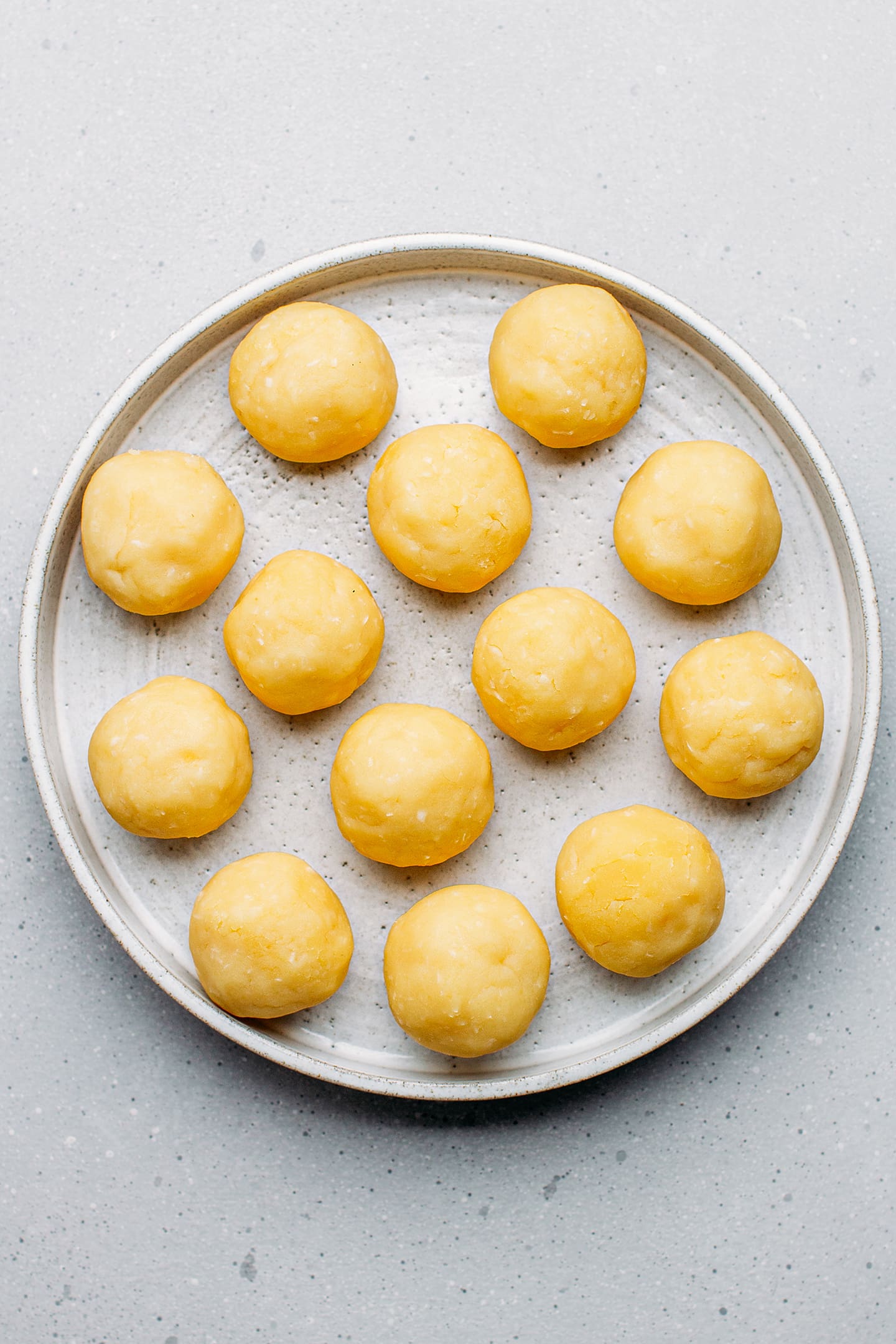
Prepare the dough
- Combine the dry ingredients. Add the glutinous rice flour, sugar, rice flour, baking powder, and salt to a mixing bowl. Whisk to combine.
- Add the water and knead. Add the water and oil and knead using your hands until it forms a slightly firm dough. The dough should hold together when you press it between your fingers. Let the dough rest covered for 30 minutes (this will allow the flour to absorb the moisture).
Note: The moisture in the dough will affect how puffy the balls will get. A slightly dryer dough will result in larger balls with a more hollow inside. This recipe will give you midly hollow sesame balls. If you want them to be more hollow, use a bit less water.
Assemble
- Flatten a ball of dough. Scoop out 1.5 tablespoons of the rice flour dough and roll it into a ball. Next, use your hands to shape it into a 2.5-inch (6cm) circle. Slightly press the edges to make them a bit thinner than the center.
- Place a ball of mung bean paste on top. Take a mung bean paste ball and place it in the center of the wrapper.
- Wrap it tightly with the wrapper. Carefully wrap the wrapper tightly around the mung bean paste ball, trying not to let any air hole inside. Press to seal.
- Roll it between your hands. Roll the ball between the palms of your hands. This will help the wrapper to get an even thickness.
- Dip in sesame seeds. Transfer the ball to a bowl filled with raw sesame seeds and roll it to coat. Slightly press the sesame seeds onto the ball to make them stick. Transfer the sesame-coated ball to a plate.
- Repeat with the remaining filling. Repeat with the remaining mung bean balls and dough. You should end up with about 12 balls.
Fry
- Heat the oil. Heat 3 cups of frying oil in a deep saucepan. Let the oil heat for at least 5 minutes. You can test if the oil is hot enough by dipping a wooden chopsticks into it. If you see a lot of small bubbles forming around the chopstick, the oil is hot enough.
- Fry the sesame balls. Carefully transfer 4-5 balls to the oil and stir using a wooden spoon or chopsticks to prevent them from sticking to the bottom of the pan. Keep frying, stirring constantly, until the balls are golden brown. This step will take 5-7 minutes, so be patient.
- Transfer to kitchen paper towels. Using a slotted spoon, remove the banh cam from the oil and transfer them to a plate lined with kitchen paper towels to remove excess oil.
- Enjoy! Let the banh cam cool for at least 25 minutes before enjoying it!
📔 Tips
- Do not make the shell too thick. Using more dough to wrap the mung bean balls can be tempting. However, I do not recommend using more than 1.5 tablespoons. Otherwise, you will end up with a shell that is hard to chew. A thin and crispy shell tastes best here.
- Slightly press the sesame seeds on the dough. To prevent the sesame seeds from falling during frying, ensure you are slightly pressing them onto the dough.
- Ensure the oil is hot enough. If your frying oil is not hot enough, the balls will stick to the bottom of the pan, and you will end up with a mess. The oil should be between 365F and 380F (185°C and 193°C). If you don’t have a thermometer, dip a wooden spatula or chopsticks into the hot oil. If tiny bubbles form around it, the oil is hot enough. If no bubbles form, keep heating the oil.
- Be patient when frying. These sesame balls can take up to 7-8 minutes before puffing and turning golden brown, so be patient and do not try to turn the heat up.
- Keep stirring. In order to achieve an even golden brown color, continuously stir using a spatula or chopsticks during the whole frying time.
- Enjoy on the same day. Just like any fried food, Bánh cam tastes best the same day. After that, the dough will soften and become a bit more chewy.
🫘 Variations
- Use a different filling: While traditionally, bánh cam is prepared with yellow mung bean filling, it can also be made with red bean paste (anko).
- Dip in caramel: Want to take these to the next level? Prepare a caramel and quickly dip the sesame balls into it!
- Use leftover dough to make donut holes. If you have leftover dough or don’t want to make the mung bean filling, you can fry the dough alone. Roll it into small balls, dip it into sesame seeds, and fry it for a few minutes!
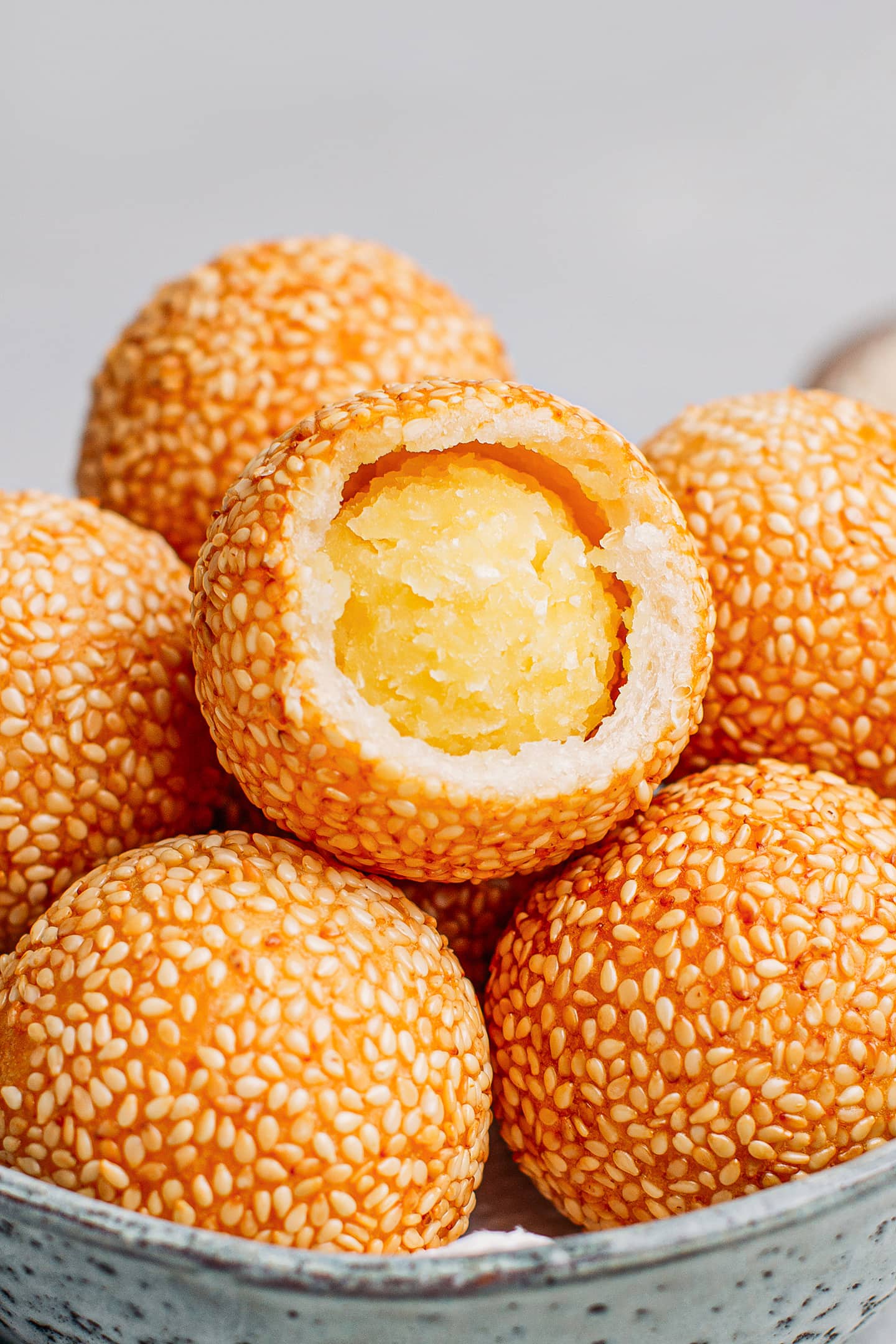
❄️ Storing and Reheating
- To store: Store the banh cam in an airtight container at room temperature for up to 2 days. They tend to become softer after 12-16 hours but are still delicious!
- To reheat: You can reheat these sesame balls in an air-fryer or an oven. The first option yields the best results as it helps bring back some of the crunchiness.
💬 FAQ
Both work. However, a food processor has less trouble processing the thick paste.
If your mung bean filling appears too soft and/or moist, put it back on the stove and dehydrate it for another few minutes. The mung bean filling should have a texture similar to Play-doh.
You either omitted the baking powder or your wrapper dough was too moist.
For optimal texture and flavor, these sesame balls must be served the same day. You can, however, make the mung bean filling up to 2 days in advance. The dough must be prepared right before frying.
There are a couple reasons for that. The first one, is that you didn’t press the sesame seeds onto the dough after dipping it into the sesame seeds. The second is that your dough was too dry and sesame seeds couldn’t stick to it.
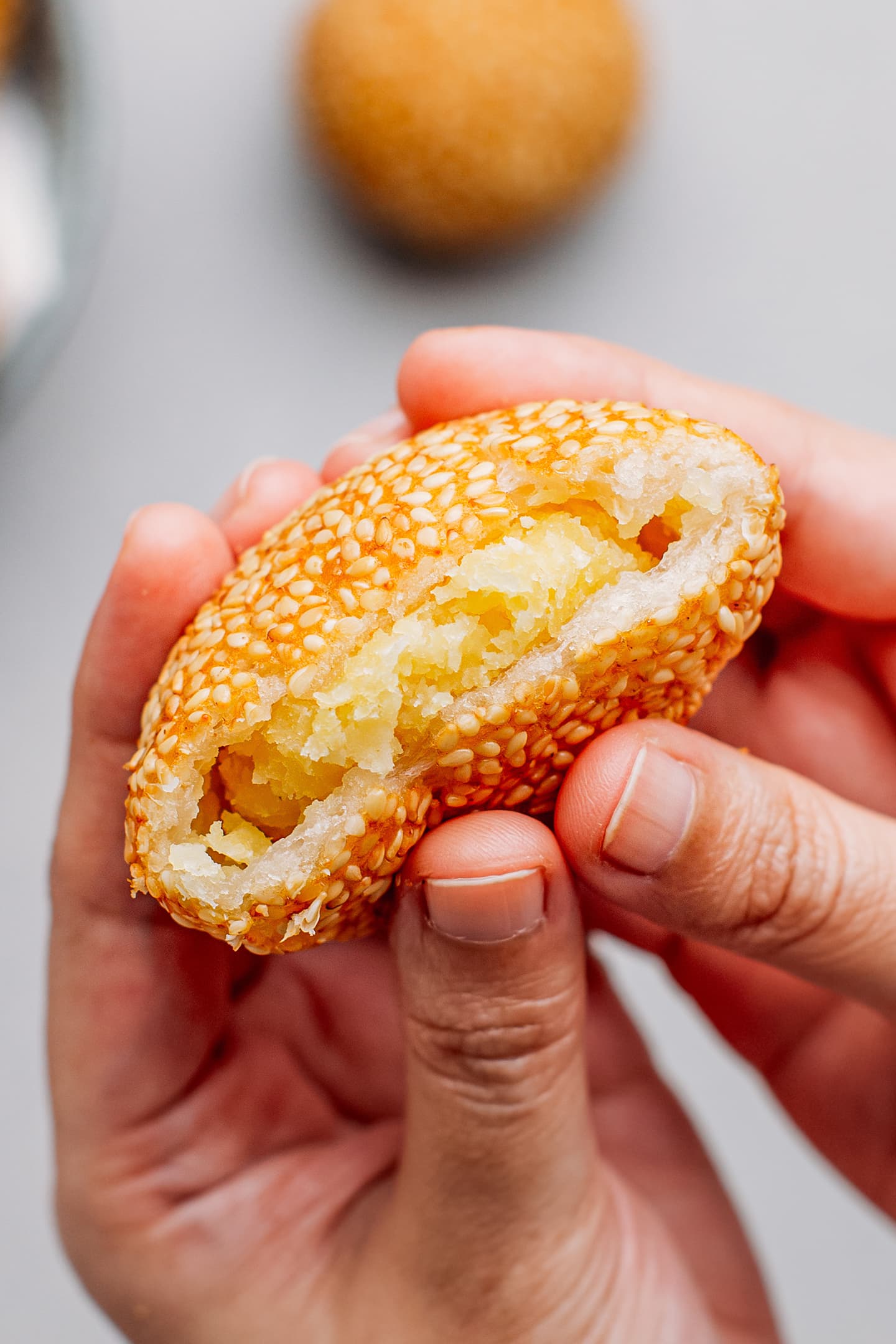
I hope you are going to love this bánh cam recipe! It’s a delicious treat that is crispy, chewy, and tender at the same time. It’s not overly sweet and super fun to prepare!
🇻🇳 More Vietnamese-Inspired Sweets
⭐️ Did you like this recipe? Let us know in the comments below, and tag us on Facebook, Instagram, or Pinterest!
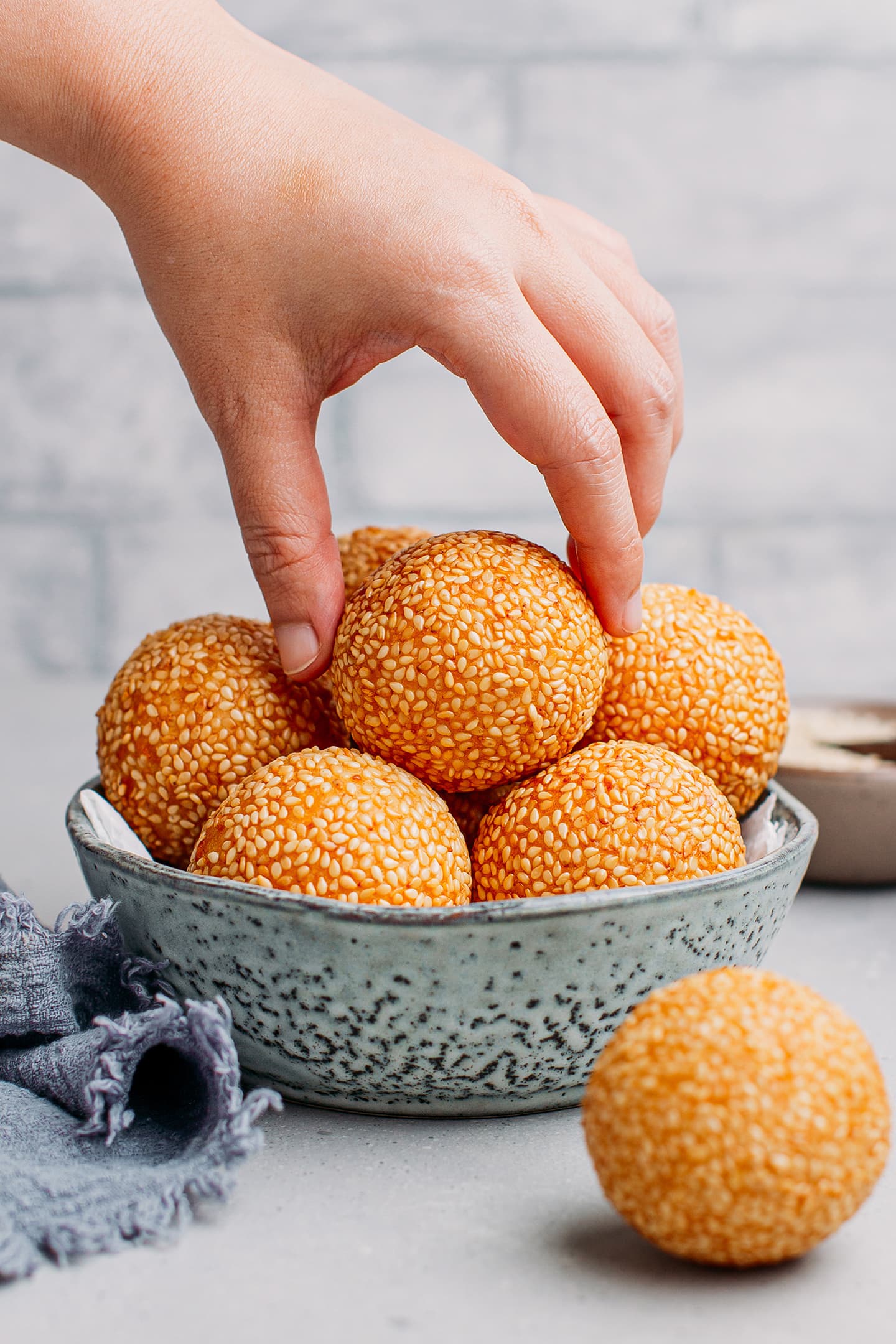

Save this recipe!
Enter your email below and I’ll send it to your inbox!
Plus, you will receive new recipes every week!
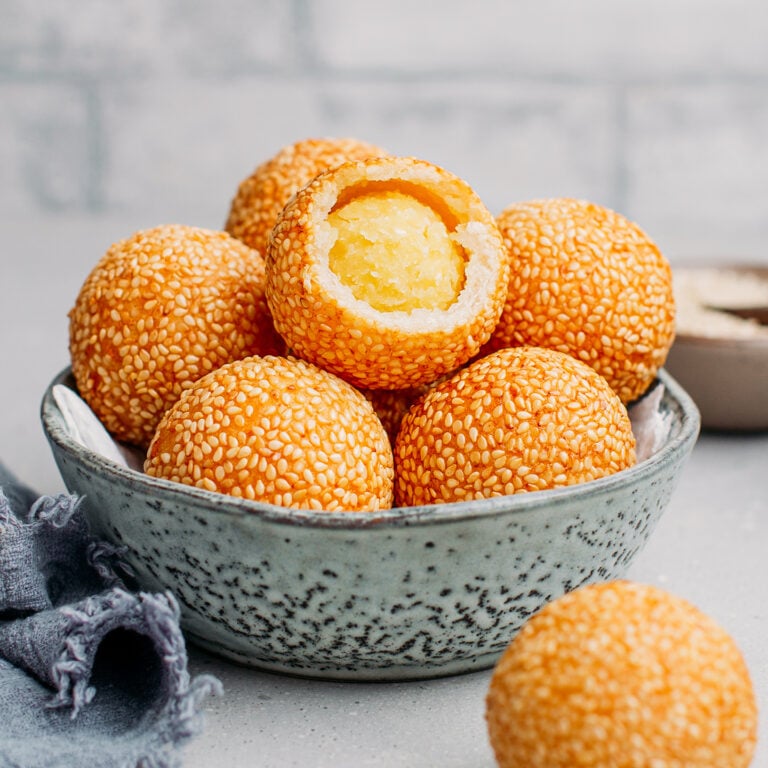
Banh Cam (Vietnamese Sesame Balls)
Equipment
Ingredients
Mung bean filling
- 105 g split yellow mung beans
- 180 ml water
- 50 g granulated sugar
- 8 g unsweetened shredded coconut
- 22 ml oil
- 1/2 tsp vanilla extract
- 1/8 tsp salt
Dough
- 135 g glutinous rice flour
- 55 g granulated sugar
- 7 g white rice flour
- 1/2 tsp baking powder
- 1/8 tsp salt
- 90 ml water
- 5 ml oil
- 45 g raw sesame seeds
- 3 cups oil for frying
Instructions
Mung bean filling
- Soak the mung beans. Start by soaking the yellow mung beans in water for 4-6 hours. This will allow them to soften and shorten the cooking time.
- Cook them. After soaking, drain and rinse the beans a couple of times. Transfer them to a medium saucepan and cover with water. Bring to a simmer and cook uncovered for 12-15 minutes or until the mung beans are soft. Keep cooking until no more water remains and the beans start turning into a purée.
- Process the paste. Transfer the cooked beans to a food processor or small blender. Add the sugar, shredded coconut, oil, vanilla extract, and salt. Process the mung bean paste for 20-30 seconds or until smooth. Be aware that the paste will be very thick and sticky. It’s normal.
- Dehydrate. Transfer the mung bean paste to a large saucepan and heat over low-medium heat. Keep stirring the paste using a spatula for 3-5 minutes or until smooth. The paste should still be soft but not sticky anymore.
- Let it cool. Transfer the mung bean paste to a bowl and cover it with plastic wrap, touching the top, to prevent the paste from forming a crust. Let it cool for at least 1 hour.
- Shape into balls. Once the paste is not hot anymore, scoop out balls of about 1 and 1/2 tablespoons. I recommend using a medium cookie scoop to speed up the process. Use your hands to shape them into round balls. Transfer to a plate and cover with plastic wrap.
- Chill. Finally, let the mung bean paste balls chill for at least 6 hours or overnight in the refrigerator.
Dough
- Combine the dry ingredients. Add the glutinous rice flour, sugar, rice flour, baking powder, and salt to a mixing bowl. Whisk to combine.
- Add the water and knead. Add the water and oil and knead using your hands until it forms a slightly firm dough. The dough should hold together when you press it between your fingers. Let the dough rest covered for 30 minutes (this will allow the flour to absorb the moisture).
Assemble
- Flatten a ball of dough. Scoop out 1.5 tablespoons of the rice flour dough and roll it into a ball. Next, use your hands to shape it into a 2.5-inch (6cm) circle. Slightly press the edges to make them a bit thinner than the center.Place a ball of mung bean paste on top. Take a mung bean paste ball and place it in the center of the wrapper.
- Wrap it tightly with the wrapper. Carefully wrap the wrapper tightly around the mung bean paste ball, trying not to let any air hole inside. Press to seal.
- Roll it between your hands. Roll the ball between the palms of your hands. This will help the wrapper to get an even thickness.
- Dip in sesame seeds. Transfer the raw sesame seeds to a small bowl. Dip the ball into the sesame seeds and toss to coat. Slightly press the sesame seeds onto the ball to make them stick. Transfer the sesame-coated ball to a plate.Repeat with the remaining filling. Repeat with the remaining mung bean balls and dough. You should end up with about 12 balls.
Fry
- Heat the oil. Heat 3 cups of frying oil in a deep saucepan. Let the oil heat for at least 5 minutes. You can test if the oil is hot enough by dipping a wooden chopsticks into it. If you see a lot of small bubbles forming around the chopstick, the oil is hot enough.
- Fry the sesame balls. Carefully transfer 4-5 balls to the oil and stir using a wooden spoon or chopsticks to prevent them from sticking to the bottom of the pan. Keep frying, stirring constantly, until the balls are golden brown. This step will take 5-7 minutes, so be patient.
- Transfer to kitchen paper towels. Using a slotted spoon, remove the banh cam from the oil and transfer them to a plate lined with kitchen paper towels to remove excess oil.
- Enjoy! Let the banh cam cool for at least 25 minutes before enjoying it!
Notes
- Do not make the shell too thick. Using more dough to wrap the mung bean balls can be tempting. However, I do not recommend using more than 1.5 tablespoons. Otherwise, you will end up with a shell that is hard to chew. A thin and crispy shell tastes best here.
- Slightly press the sesame seeds on the dough. To prevent the sesame seeds from falling during frying, ensure you are slightly pressing them onto the dough.
- Ensure the oil is hot enough. If your frying oil is not hot enough, the balls will stick to the bottom of the pan, and you will end up with a mess. The oil should be between 365F and 380F (185°C and 193°C). If you don’t have a thermometer, dip a wooden spatula or chopsticks into the hot oil. If tiny bubbles form around it, the oil is hot enough. If no bubbles form, keep heating the oil.
- Be patient when frying. These sesame balls can take up to 7-8 minutes before puffing and turning golden brown, so be patient and do not try to turn the heat up.
- Keep stirring. In order to achieve an even golden brown color, continuously stir using a spatula or chopsticks during the whole frying time.
- Enjoy on the same day. Just like any fried food, Bánh cam tastes best the same day. After that, the dough will soften and become a bit more chewy.
Nutrition

About the Author
Thomas Pagot is the founder, photographer, and recipe developer behind Full of Plants. He created the blog in 2016 as a personal cookbook for vegan recipes. Through years of recipe development, Thomas has successfully grown Full of Plants into a trusted resource for plant-based recipes.

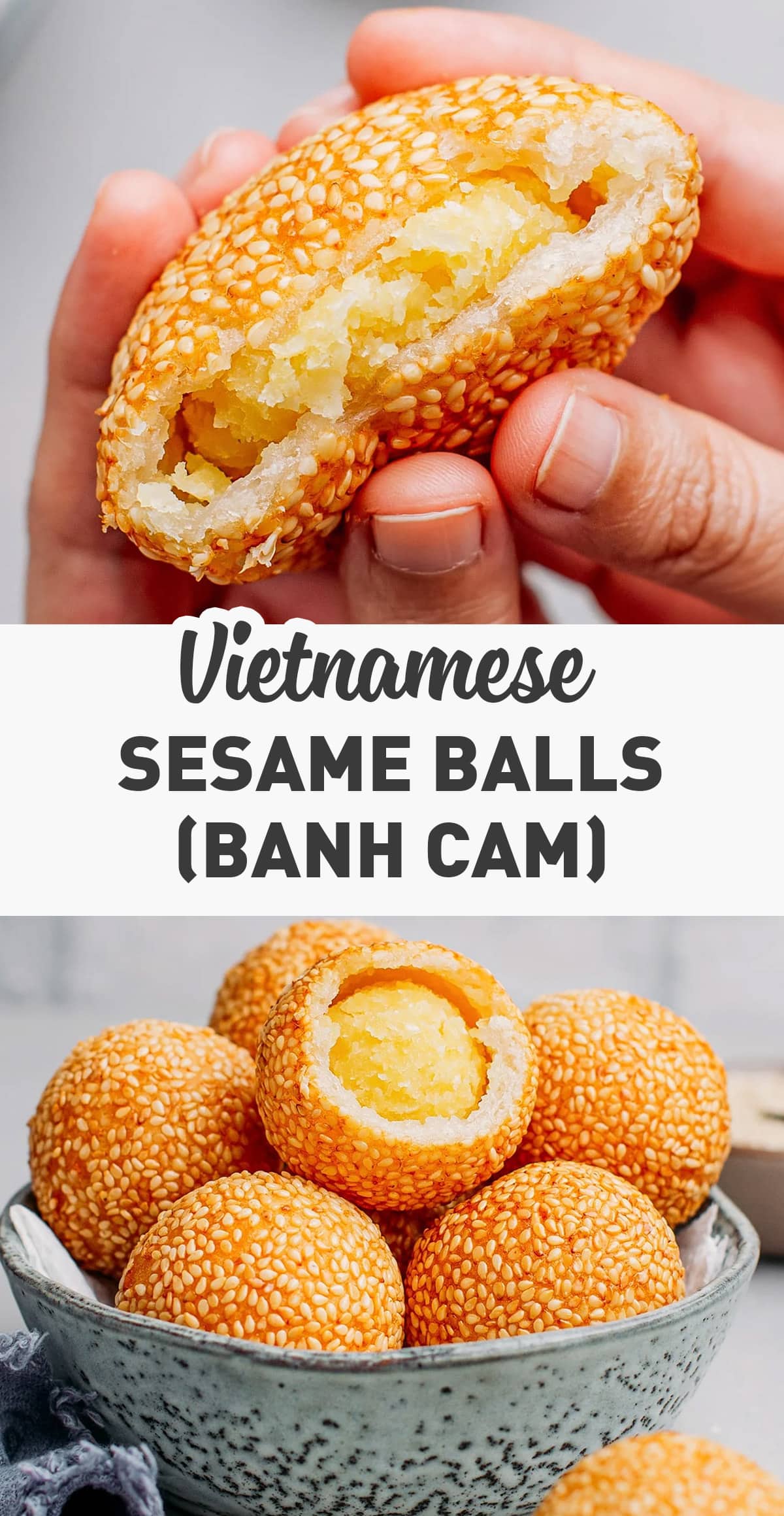


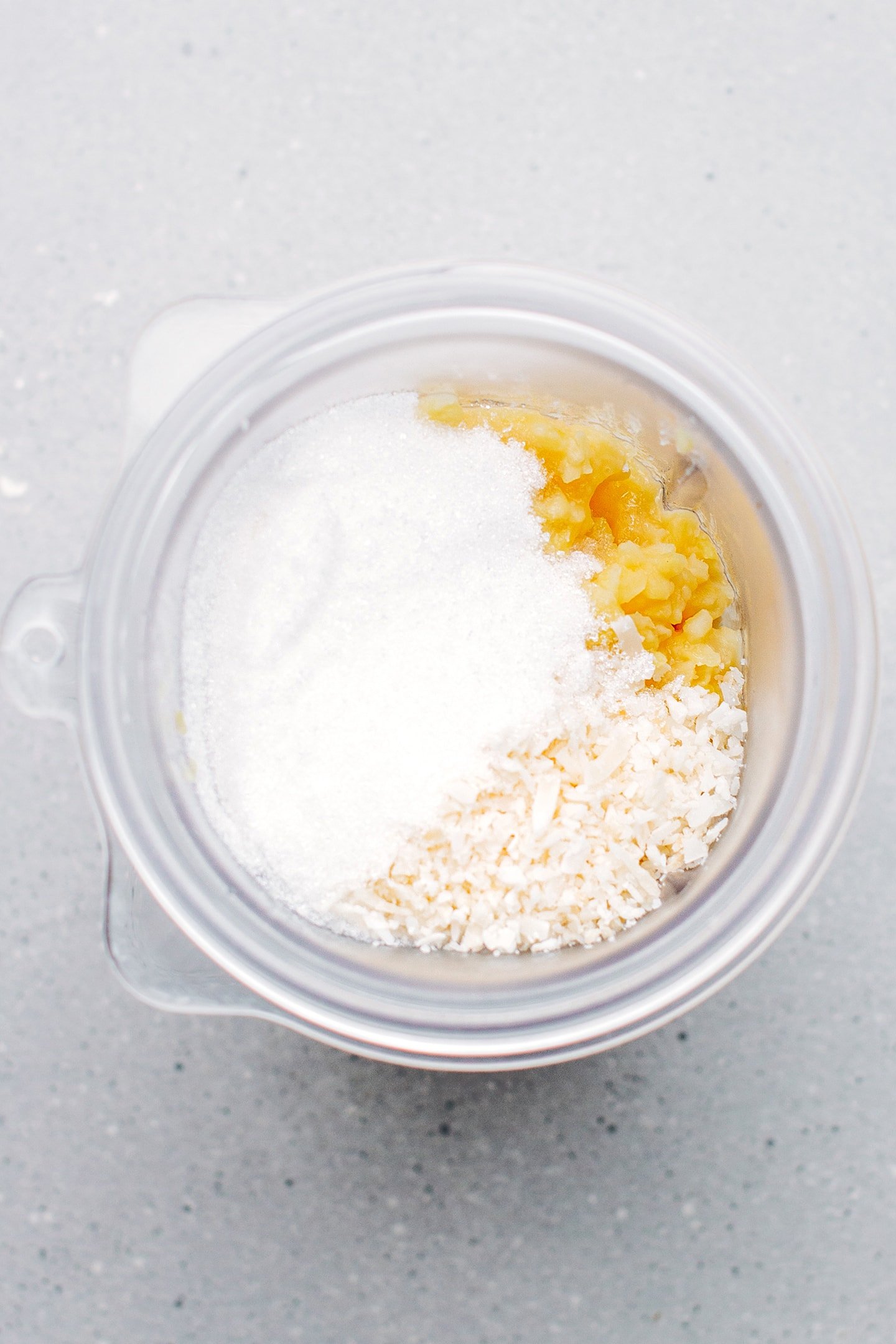
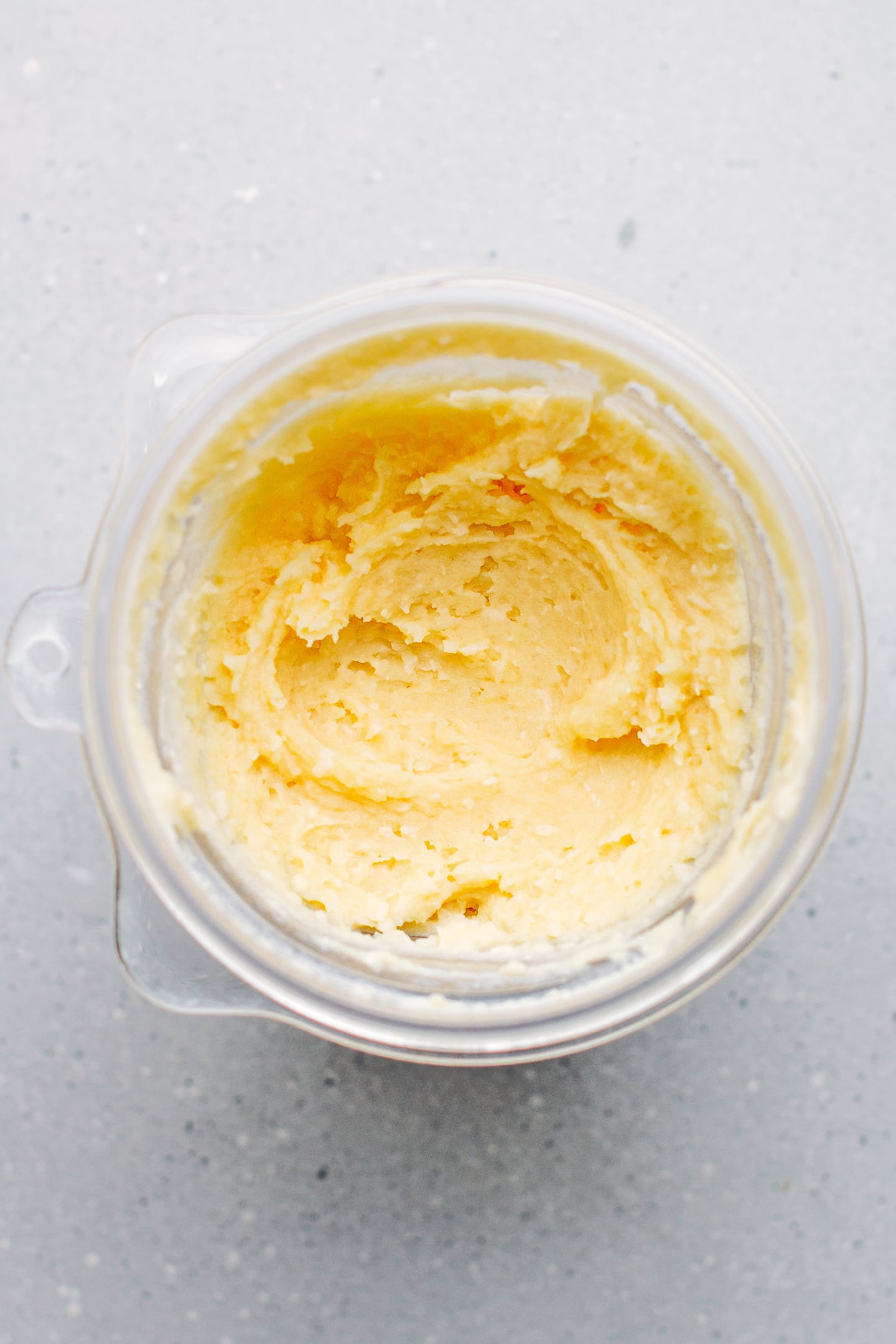



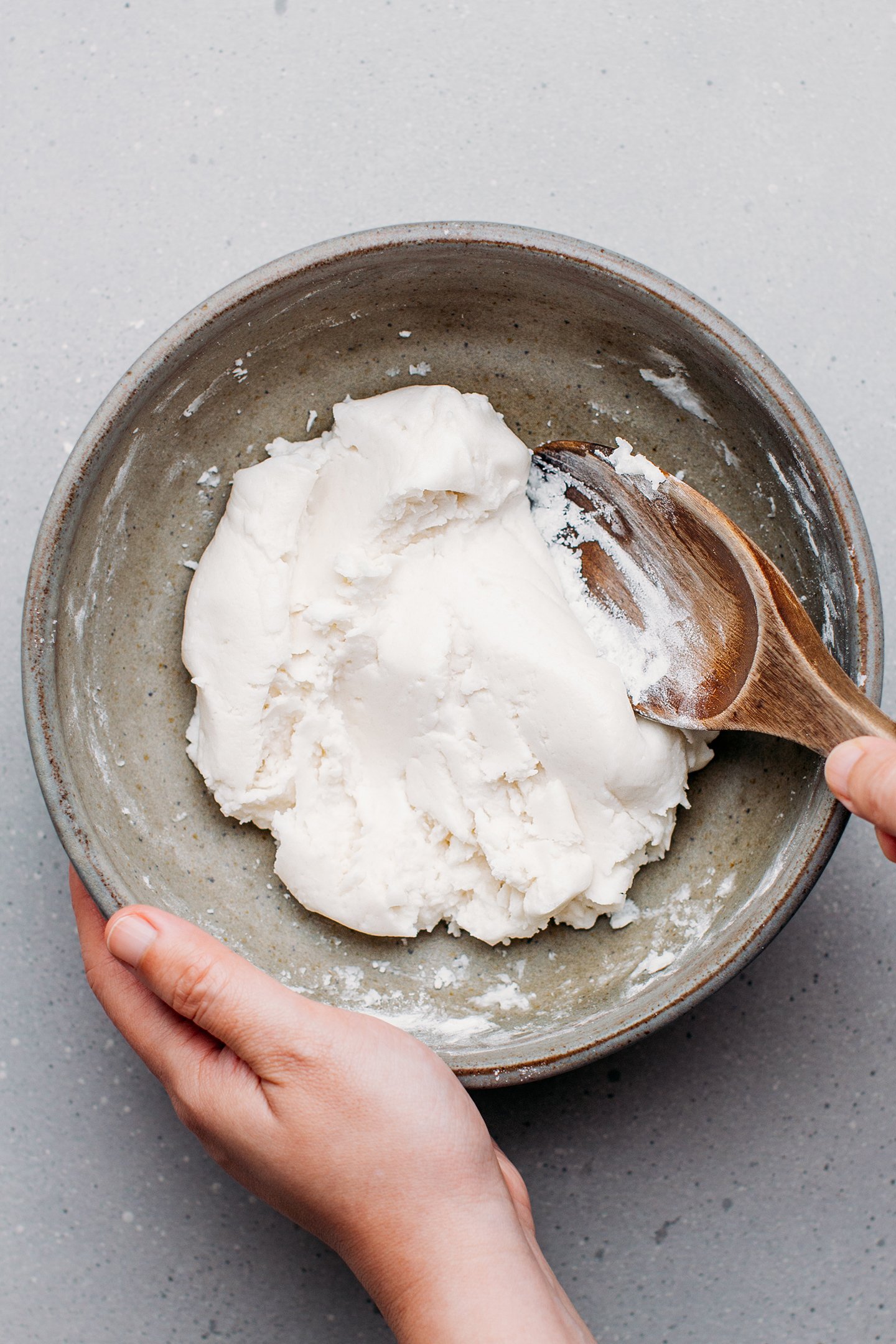
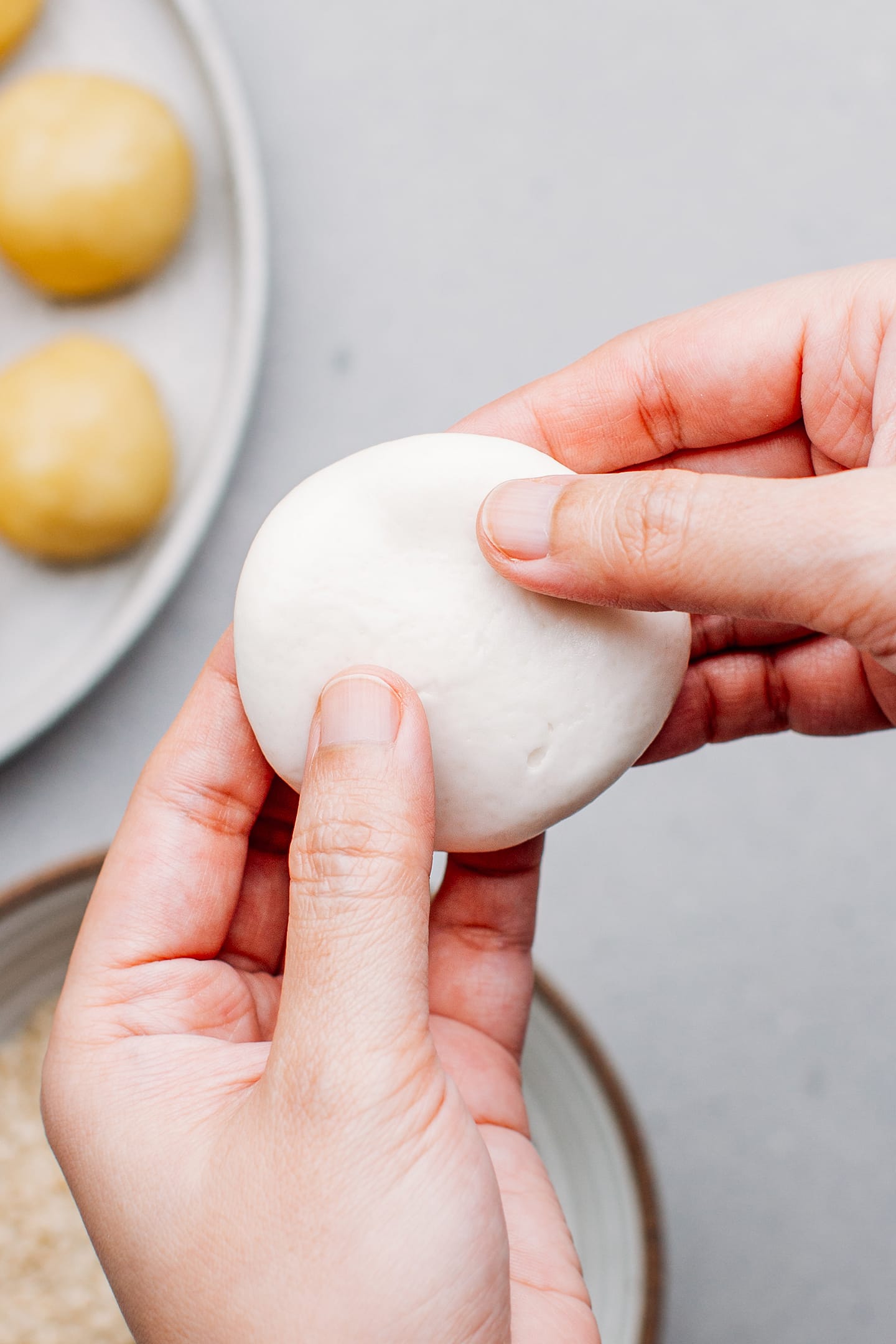


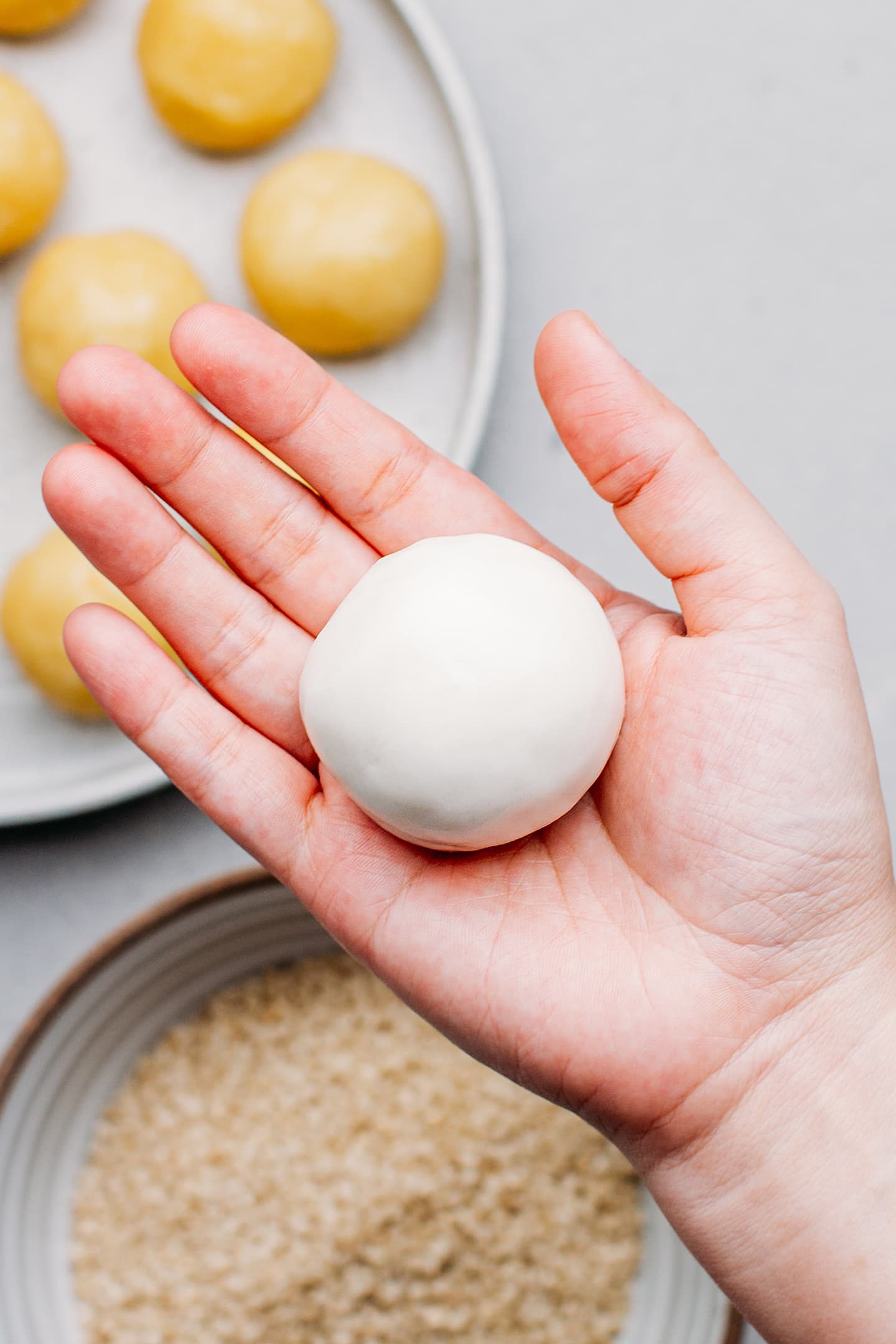





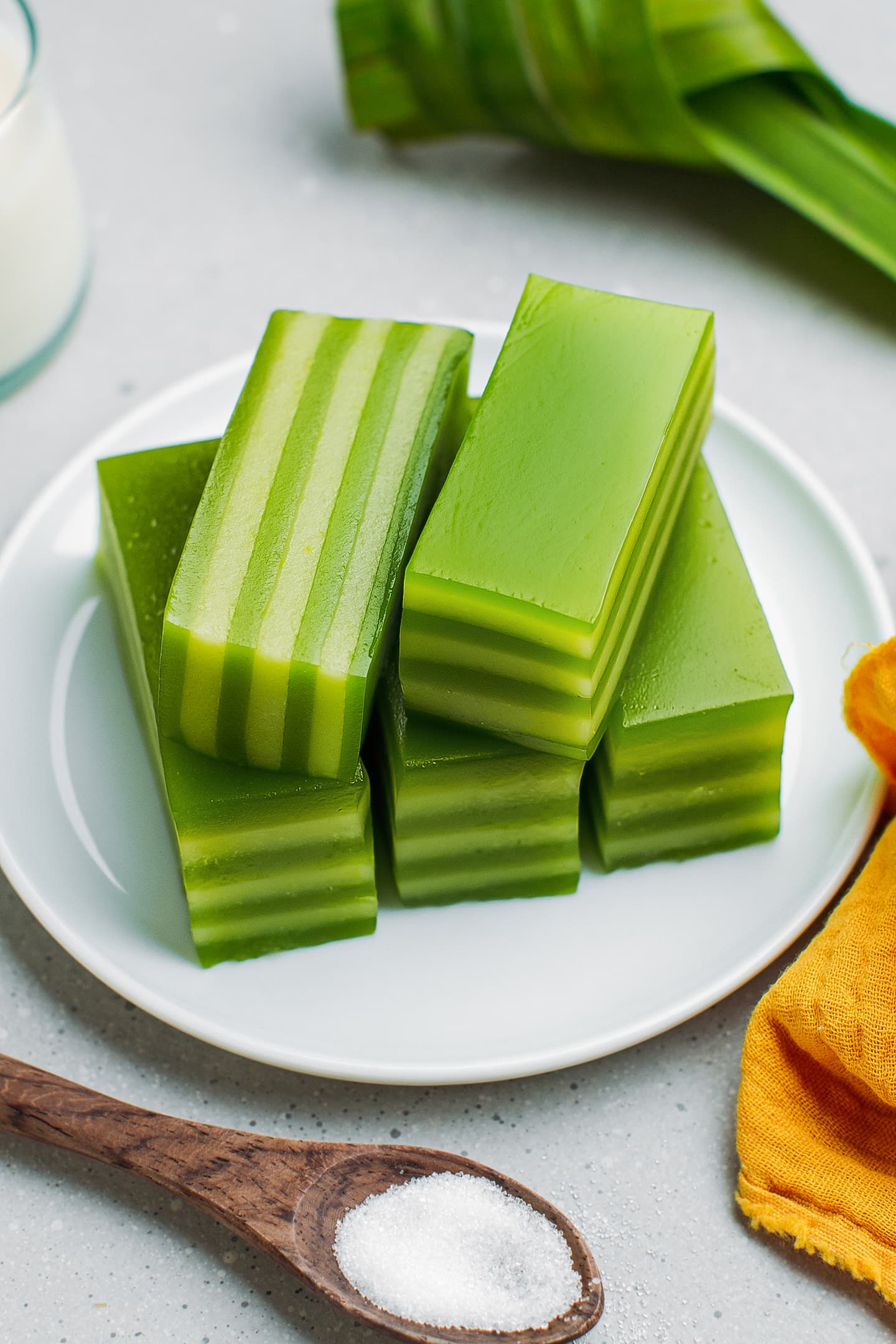
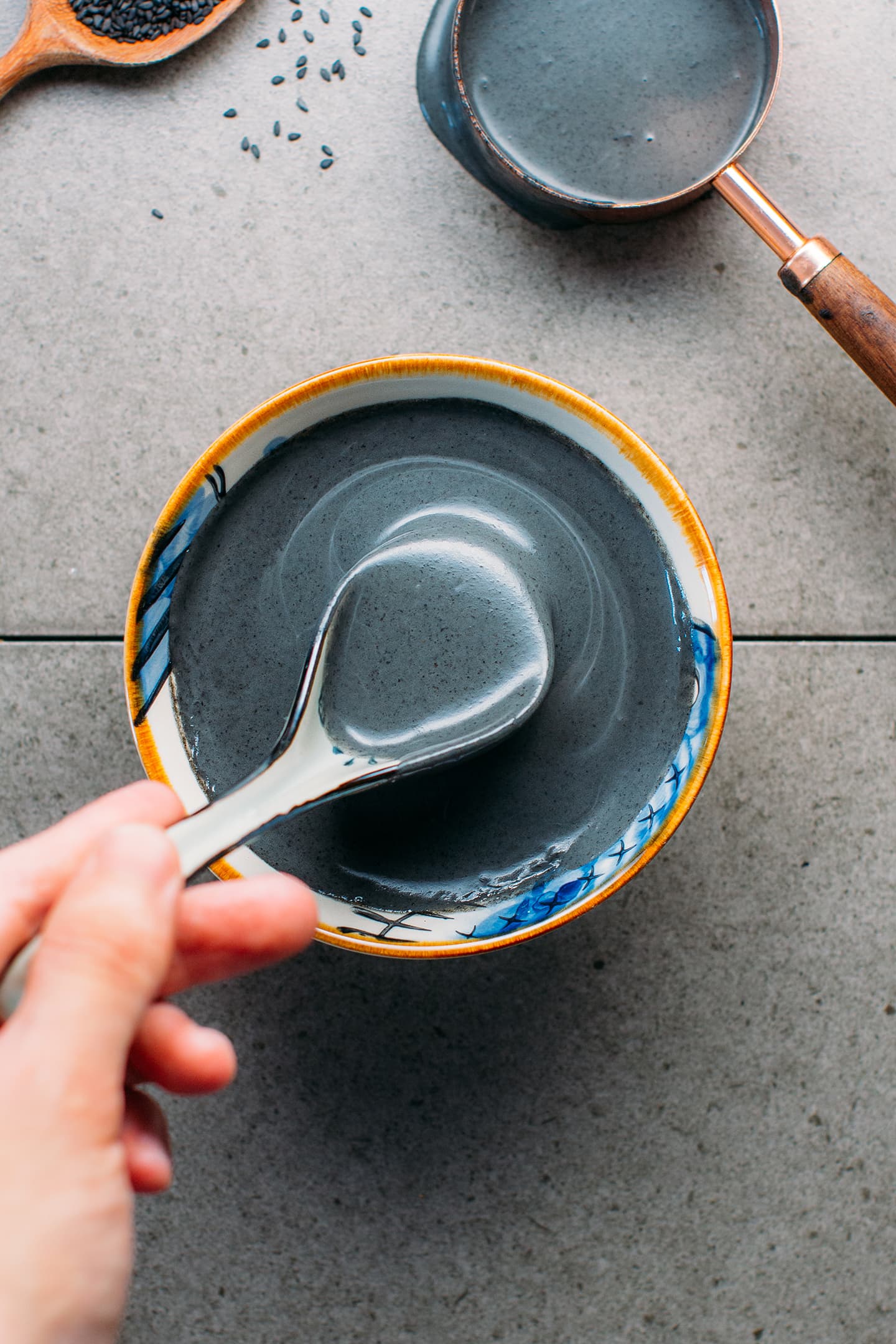


Leave a Comment
Hi Thomas, these look DELICIOUS.
Do you think you could fry these in an air fryer instead of deep frying? Or would that be sacrilegious…
Thanks
Hi Zoe,
I am afraid it won’t work. These must absolutely be deep-fried 🙂
Oh wow! I’ll get to these one day☺️
Thanks for posting!
You are welcome Tetyana 😉
Looks amazing. I must try this recipe for my family. Thank you for sharing.
Thanks Emy! Let me know how it turns out!